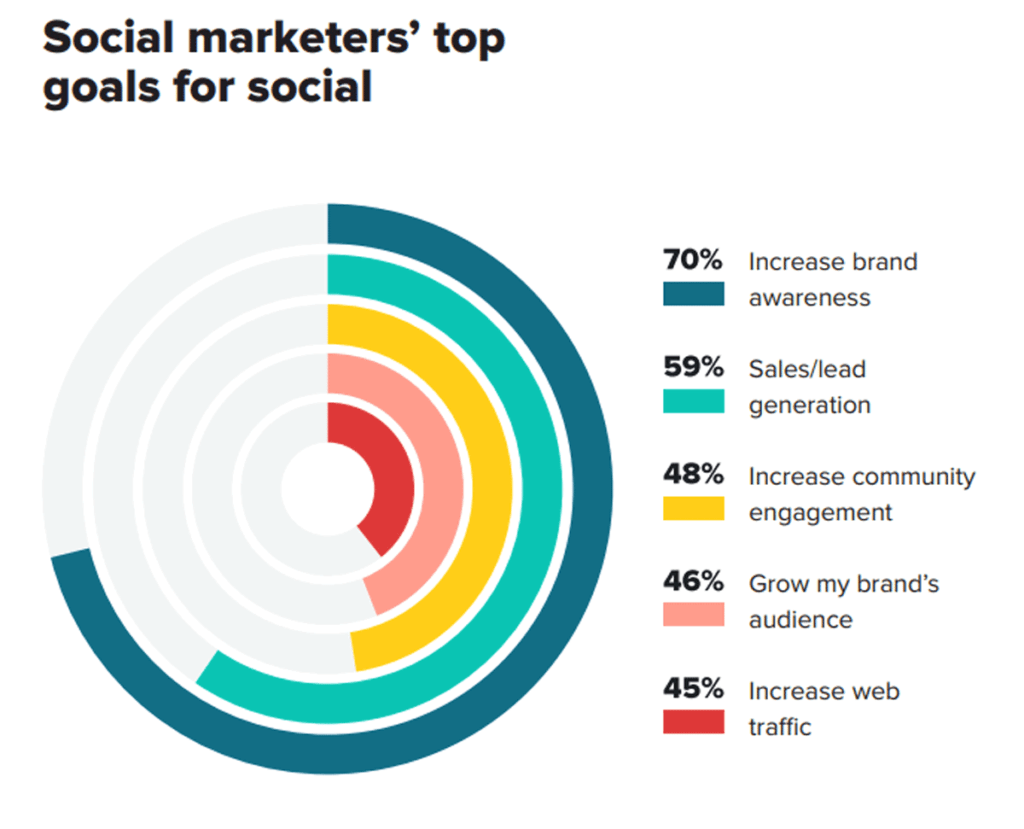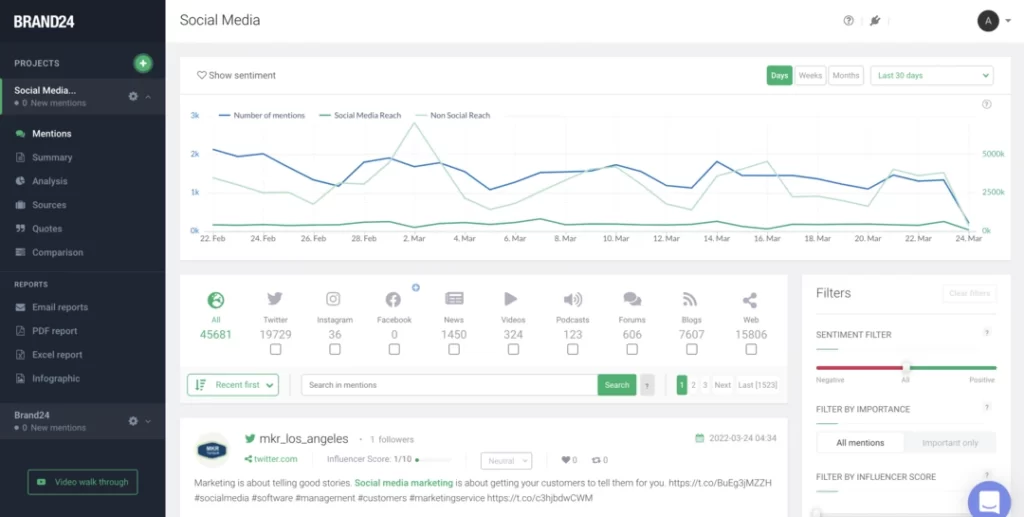How to Create a Social Media Marketing Plan
Social media has evolved dramatically over the past decade, transforming from a niche platform into an indispensable marketing tool for businesses of all sizes. As of 2023, a staggering 4.9 billion people use social media worldwide. With over two-thirds of internet users active on social networks, marketing strategy today is only complete with incorporating social media.
But simply creating social media accounts and posting sporadically will not cut it anymore. You need a thoughtful and data-driven social media marketing plan to stand out and engage meaningfully with your audience.
This blog post will dive into the critical components of crafting a results-driven social media strategy in today's highly competitive landscape. We will look at the latest social media statistics and trends to help you:
- Identify the right social platforms for your brand and target audience.
- Set concrete social media goals and KPIs that align with your broader business objectives.
- Learn how to create engaging and shareable multimedia content tailored for each platform.
- Master social listening to monitor mentions, conversations, and feedback.
- Leverage analytics to glean insights and measure your campaign's performance.
- Optimise campaigns regularly based on collected data and metrics.
With a well-defined social media marketing plan, you can humanise your brand, boost visibility, increase website traffic, convert leads, and ultimately boost sales. The tips provided in this article will help you maximise your social media presence while avoiding common pitfalls. Let's get started!
Table of Contents
1: Understanding Your Audience

Social media marketing allows brands to reach and engage with their target audience online. But before creating any social media campaigns, thoroughly research and understand your ideal customers.
Start by gathering both quantitative and qualitative data about your potential customers. Valuable areas to research include:
- Demographics: Age, gender, location, education, income level, marital/family status, etc Look at census data, surveys, and past marketing analytics to identify demographic traits of current and prospective customers.
- Interests and Values: What motivates your audience, and what do they care about? Learn about their hobbies, causes, preferences and priorities in life. Social listening and focus groups can provide insights.
- Pain Points: What challenges, pain points, and problems does your audience face? What needs could your product or service address? Customer interviews and reviews may reveal pain points.
- Online Behaviour: Where does your audience spend time online? Analyse web traffic, social media, search trends and app usage to understand their digital media habits.
Leverage Analytics for Consumer Insights
Marketing analytics tools like Google Analytics and social media analytics can reveal valuable data on your potential customers' digital behaviours and interests. Track metrics like:
- Most visited websites and apps
- Social media platforms used and how active they are
- What search terms do they use
- How they interact with online content
- Demographic and psychographic analytics
Build Detailed Buyer Personas
Use your research to build one or more fictionalised representations of your ideal customers. Include relevant details like:
- Name, age, location, occupation, family, goals, challenges, etc.
- What motivates them? What are their interests and passions?
- What social platforms and media do they use? How do they interact with brands?
- What are their pain points related to your product or service?
- What content format do they prefer? (video, text, audio, etc.)
Developing strong buyer personas for social media marketing allows you to tailor content, engagement tactics and ad targeting to connect with your audience correctly. Always seek new data and insights to refine your understanding of what makes your customers tick.
2: Setting Clear Goals

Creating clearly defined goals is a critical first step to ensure the success of any marketing campaign. Plans should follow the SMART framework – Specific, Measurable, Achievable, Relevant, and Time-bound. This helps provide focus and metrics to track progress.
The goals for a social media marketing plan should tie directly to the overall business objectives. Some examples of potential social media goals include:
Increasing Brand Awareness
- Aim to reach x number of new followers per month
- Get x number of impressions on key brand posts per quarter
- Run a brand awareness social ad campaign targeting relevant demographics by Q3 2023
Driving Website Traffic
- Increase website click-throughs from social posts by x% over last year
- Achieve x% increase in site traffic from social referrals by Q4 2023
- Post content focused on high-priority keywords 3x per week
Boosting Lead Generation
- Generate x new leads per month via social channels
- Reduce cost per lead from social by x% by Q2 2023
- Promote lead gen offers and content in social ads and organic posts
Enhancing Customer Engagement
- Improve engagement rate on posts by x% year-over-year
- Respond to 100% of comments and queries within 24 hrs
- Launch a social media customer service initiative by Q1 2024
Improving Brand Sentiment & Reputation
- Maintain positive sentiment of over x% in social conversations
- Resolve customer complaints publicly within 24 hrs
- Proactively seek and respond to all negative reviews by the end of Q3
Setting SMART goals based on key business objectives provides a focus for your social media initiatives and allows you to benchmark progress and pivot as needed to achieve desired results. The key is aligning goals to broader business aims, making them specific and measurable, and establishing clear timeframes for completion. This formula is critical for any successful social media marketing plan.
3: Choosing the Right Platforms

With so many platforms available, brands and businesses need to be strategic about which ones they focus on based on their target market, business goals and the type of content they want to create.
Facebook continues to be the biggest social media platform, with almost 3 billion monthly active users. It's great for reaching a wide demographic, promoting products, driving traffic to your website and fostering community engagement through comments and shares. Facebook Ads also make it easy to reach specific target audiences.
Instagram is the place to showcase visually appealing content like photos and videos. With over 2.35 billion monthly active users, it's popular among millennials and Gen Z. Instagram Stories and Instagram Live are great for real-time raw content to engage followers. Instagram Ads allow targeting users by interests, behaviours and demographics.
With its 300 million monthly active users, Twitter (or X) is ideal for short bites of content, engagement through tweeting and staying on top of trends. Its real-time nature and use by journalists, celebrities and politicians make it a platform for news, conversations and amplification. Twitter Ads can help expand reach and engagement.
YouTube has over 2.68 billion monthly logged-in users. It's the leading platform for video content. Creating a YouTube channel and consistently posting engaging videos can help grow your subscriber base. YouTube Ads help promote your videos to interested viewers.
LinkedIn houses a bustling community of 310 million members, predominantly professionals. It's the quintessential platform for B2B marketing, delivering thought leadership content, generating vibrant leads, addressing recruitment needs, and fostering industry connections, especially when using AI recruiting software. Dive into the realm of LinkedIn Sponsored Updates and Sponsored InMail to precisely target your posts and make a splash in your sector!
Pinterest has over 450 million monthly active users, primarily women. Its visual nature is ideal for lifestyle, fashion, recipes, travel and pictorial storytelling boards. Pinterest Ads let you promote your pins to a targeted audience.
The key is strategically choosing 1-3 social platforms that align with your brand, audience and goals. Focus on creating high-quality content suited for each platform and leverage paid advertising options to expand reach and engagement—Analyse performance regularly to optimise efforts. A strategic social media presence can build meaningful connections with your audience.
| Platform | Strengths |
|---|---|
| Broad reach, diverse demographics, excellent for building brand communities | |
| Highly visual, ideal for lifestyle, fashion, and visually appealing products | |
| Real-time updates, perfect for quick interactions and customer service | |
| Professional networking, B2B marketing, and industry-specific content | |
| TikTok | Short-form video content, ideal for younger audiences and trending challenges |
| YouTube | Video sharing, long-form content, ideal for tutorials, and educational videos |
4: Content Strategy and Creation

Creating compelling and relevant content is the cornerstone of any successful social media marketing strategy. Your content should resonate with your target audience and align with your brand's values and messaging.
To keep your audience engaged, use a variety of formats and storytelling techniques across your social platforms:
- Craft an editorial content calendar to plan your posts and campaigns well. Mapping out your content plan for the quarter or year will help you maintain a consistent cadence and voice across channels.
- Incorporate visual formats like photos, videos, infographics, and graphics into your mix. Visuals help grab attention and break up blocks of text. Consider creating short videos to showcase your products or team, or use Canva to design informative graphics and visual quotes.
- Leverage user-generated content (UGC) by encouraging your audience to tag your brand in their posts or share their brand experiences. Featuring real customer photos and videos builds trust and authenticity. Run UGC campaigns to generate branded visual assets you can reuse.
- Utilise storytelling techniques to connect emotionally with your followers. Share behind-the-scenes company stories, employee spotlights, or brand history snippets. Narrate how your products are made or how they positively impact customers.
- Stay topical and tie into trends, current events, or holidays where appropriate. Use relevant hashtags to insert your content into more extensive conversations. For example, connect Earth Day promotions to your sustainability efforts.
A compelling social media content mix informs and entertains your audience while highlighting your brand personality, values, and products. The key is providing value through varied and engaging storytelling. Consistency, quality over quantity, and understanding your audience will help your content strategy succeed.
5: Engaging with Your Audience

Social media is a two-way street that thrives on meaningful engagement between brands and their audiences. Simply posting content is not enough – you must actively participate in conversations to build relationships and loyalty.
Responding promptly to comments, messages, and mentions shows users that you listen and are interested in what they say. Make it a priority to check notifications and reply within 24 hours whenever possible. If you receive negative feedback, address it professionally and seek a resolution.
Look for opportunities to encourage discussion around your posts. Ask open-ended questions, run polls, or prompt users to share their opinions. When users feel heard, they are more likely to follow and interact with your brand over the long term.
Providing excellent customer service through social media channels is also vital. Be available to address questions, concerns, and complaints promptly. Having responsive customer support helps build trust and improve satisfaction.
Exciting your audience with contests and giveaways can further drive engagement. Partner with relevant brands to provide prizes and incentivise users to like, share, comment, and participate creatively in your campaigns.
Collaborating with influencers in your industry is another impactful strategy. Identify influencers who naturally fit your brand and invite them to help create content or promote your products. Their established credibility and audience base help expand your reach.
The key is to foster a genuine two-way connection with your followers. Encourage user-generated content, give exclusive behind-the-scenes looks, and inspire your audience creatively. Social media is an opportunity to cultivate a community that feels invested in your brand's story.
6: Analysing and Measuring Success

To continually refine and optimise your social media marketing strategy, it is essential to track and analyse key performance metrics regularly. Robust social media analytics tools provide insight into how your campaigns perform across platforms like Facebook, Instagram, Twitter, and LinkedIn. Focus on monitoring the following core social media KPIs:
Reach and Impressions: These refer to the number of unique users who saw your content pop up in their feeds or search results. High reach and impressions indicate your content is organically surfacing to a broad audience or through paid promotion. However, high reach alone does not guarantee engagement.
Engagement: Measures like comments, likes, shares, retweets, link clicks, and other interactions show how well your audience responds and connects with your content. Strong engagement metrics reflect an audience that finds your content valuable—Prioritise quality over quantity by incentivising meaningful comments and conversations over simple likes.
Click-Through Rate (CTR): The CTR metric indicates the percentage of users who saw your social post and visited your website, blog or landing page. A high CTR signifies you have compelling headlines and preview images that motivate clicks. A low CTR suggests your messaging may need optimisation to drive more traffic.
Conversion Rate: For social campaigns aimed at conversions like email sign-ups, free trial downloads, ebook requests or product purchases, monitor the conversion rate closely. This measures what proportion of visitors completed your desired action. Test different offers and creative to improve conversion rates over time.
Refresh your analytics dashboard weekly or monthly to monitor how these key metrics are trending. Periodically optimise your social content and strategy based on the latest performance data. Consistently strong KPIs indicate that your social presence and activities are effective and aligned with marketing goals. Falling metrics require a review of messaging, content types, engagement tactics and audience targeting to identify areas for improvement.
7: Evolving and Adapting
Maintaining social media trends and algorithms is crucial for effective marketing in today's digital landscape. With platforms like Facebook, Instagram, Twitter and more constantly evolving, strategies that worked previously may become outdated. Marketers must stay agile and willing to adjust their approaches to keep pace.
Regularly reviewing your social media performance metrics is critical. Look at engagement rates, click-throughs, conversions and other data points to assess what's working and what's not. If specific tactics are underperforming, it may be time to try something new.
Monitoring competitors is also insightful. Please pay attention to what types of content, formats and strategies your competitors use that resonate with their audiences. You can model what works for them while putting your unique spin on things.
Additionally, stay on top of new features rolled out by social platforms. Be an early adopter of formats like Stories, Live Videos, AR filters and more. Being among the first to experiment with a new feature helps attract attention and sets you apart.
Social media marketing is never a “set it and forget it” endeavour. The platforms and best practices are constantly shifting. Regularly reviewing performance data, keeping tabs on competitors and being willing to tweak your approaches can ensure your social media strategy stays up-to-date. Consistently evaluating what's working and what's not is critical to staying agile and effective.
Need a Social Media Marketing Plan?
A thoughtful and strategic social media marketing plan is the key to unlocking the immense potential of social media for your business. Far more than just promotional channels, social platforms allow you to build authentic relationships and vibrant communities centred around your brand. The cornerstones of an effective social strategy are understanding your audience, setting clear objectives, choosing the right platforms, creating compelling content, engaging genuinely, and analysing your efforts.
By taking the time to truly understand your audience – their interests, values, pain points – you can create content and messaging tailored specifically to them. This relevance and resonance hooks an audience and turns them into loyal brand advocates. With clear goals established from the start, whether driving conversions, boosting brand awareness, or increasing engagement, you have benchmarks to refine your strategy.
Carefully choosing platforms that align with your brand and audience ensures your efforts are concentrated where they will have maximum impact. Visually stunning and value-driven content entertains and educates your audience, sparking meaningful conversations and connections. Authenticity is critical – interactions must be genuine, not merely transactions.
The continuous analysis provides the crucial feedback loop to iterate and optimise your social media marketing plan. Consistency, creativity and human connection are the pillars that elevate your social media presence. With an adaptable strategy rooted in these principles, your brand's community will flourish across platforms. Success in today's social sphere requires understanding your audience, crafting creative content tailored to them, and engaging through compassion – the rewards for brands who embrace this mindset are limitless.
